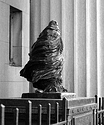Hello there!
I have been handing my development to a lab for years, but I got a Paterson tank for my birthday, with a matching Mod54 4x5 insert.
My film is Ilford Delta 100 and developer is Lmax (T-max), with Kodafix fixer. That is literally all I have

I have some issues: First off, the film sheets seem to shift when I am developing, sometimes touching each other or dropping out of the slot altogether. I have never filled the whole thing with six sheets though, so maybe it works better that way? Or maybe I agitating the tank too vigorously?
I have some small pinholes in the darker areas of the negative (bright sky) are these likely dust particles that got washed off?
Finally some images had some vague blotchy areas. I also don't have a squeegee, maybe this is water drops that dried?







